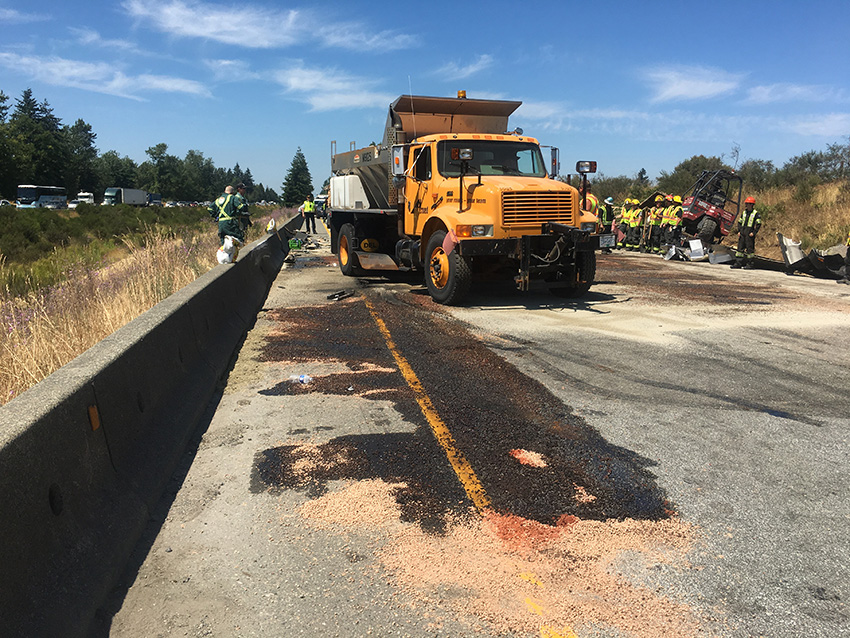Environmental Emergency Branch
The Environmental Emergency Branch (EEB) is responsible for responding to hazardous material spills and harmful substance spills impacting the environment and/or human health.
On this page
What do we do
EEB develops and implements tools to prepare for, respond to and recover from spill incidents and other environmental emergencies. EEB is dedicated to protecting the welfare of the public and environment in the event of an environmental emergency or disaster.
Branch staff
The Environmental Emergency Branch is made up of the following sections:
- Preparedness and Policy Development
- Response
- Recovery
- Flood Debris Management Secretariat
The Preparedness Section is made up of mostly policy analysts who assist in preparing for hazardous material incidents by creating standard operating procedures and guidelines, organizing outreach and engagement, and taking part in spill response exercises. Policy analysts are also tasked with updating regulations and legislation.
The Response section is made up of Environmental Emergency Response Officers (EEROs), Senior Environmental Emergency Response Officers (SEEROs), a training officer, a logistics officer and an information officer. This section is responsible for overseeing response actions during hazardous material incidents. EEROs strategically deploy to hazardous material incidents across B.C. to assess, give guidance and monitor response actions. They ensure the responsible person (the spiller) is taking the appropriate actions to clean up the spill.
The Recovery section provides technical expertise during incident response as well as post-spill. Recovery specialists ensure resources at risk are identified and properly protected during the response. Post-spill, the Recovery section follows up with spillers to ensure they are taking the appropriate actions to restore the environment.
How do we fulfill our responsibilities?
The Environmental Emergency Branch prepares for and responds to spills of hazardous materials and substances by:
- Administering the Environmental Management Act and applicable regulations: (1) Spill Reporting Regulation (PDF), (2) Spill Preparedness, Response and Recovery Regulation (PDF) and (3) Spill Contingency Planning Regulation (PDF)
- Training and supporting environmental emergency response officers to deliver field assessment and response in the province’s regions
- Establishing and managing incident management teams and technical specialists to provide assistance in emergency situations for larger scale incidents
- Maintaining a headquarters environmental emergency staff to undertake provincial, national and international response planning and liaison, policy and procedure development, and issue management
- Developing policies, procedures, plans, operational guidelines, cooperative agreements, technical documents, and establishing emergency operations centers
Mission
To protect and enhance the quality of B.C.’s water, land, and air in a way that contributes to healthy communities, a sustainable environment, and a strong, vibrant provincial economy.
Guiding principles
The fundamental principles that guide the Ministry during an environmental emergency consist of the following:
- Polluter-pay principle
The responsible person and owner of the substance or thing spilled are both responsible for spill response and recovery costs.
- Emergency management is a shared responsibility
Coordination between governments, industry, First Nations, and communities before, during and after a spill will minimize impacts to the environment and community resources.
- Emergency preparedness is based on quantitative risk analysis
To adequately prepare for spill incidents, spill contingency plans must demonstrate the ability to respond effectively to the worst-case scenario as quantified in Section 2 of the Spill Contingency Planning Regulation.
- The Environmental Emergency Branch follows the Provincial Emergency Management Structure
Emergency management is based on provincial standards and best practices.
- Response and recovery objectives are based on a net environmental benefit analysis
Net Environmental Benefit Analysis (NEBA) weighs the advantages and disadvantages of different actions to minimize the impact of the spill incident on both people and the environment.

Report a spill: 1-800-663-3456.
Find out what details the operator will ask for and more on the Report a Spill page.
For more information on the investigation and remediation of contaminated sites in British Columbia:
